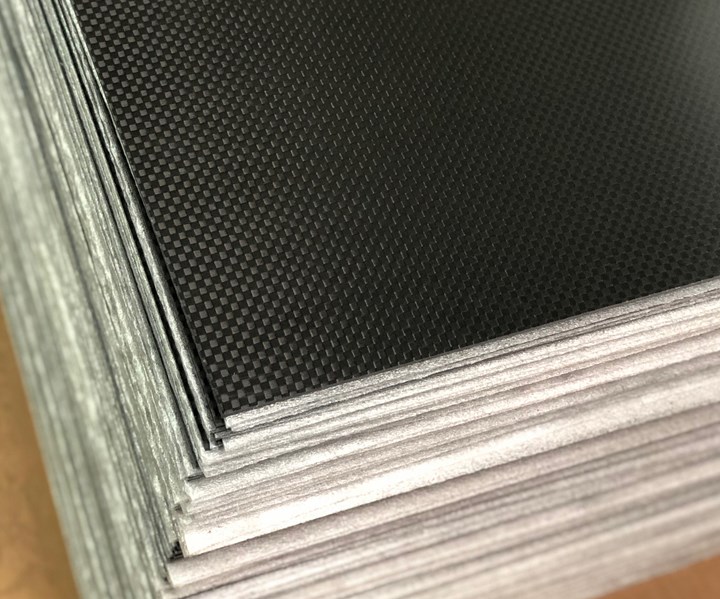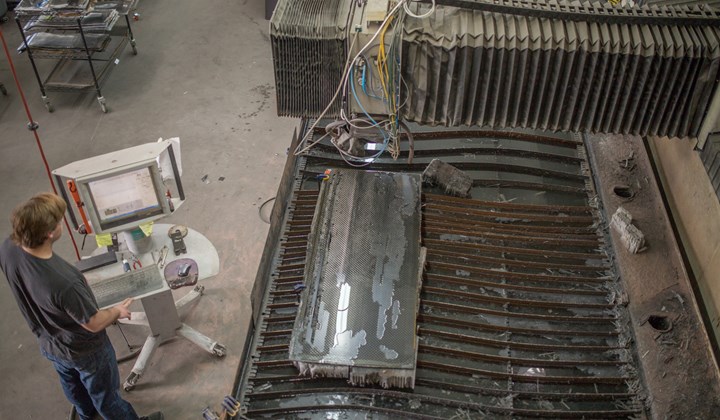From carbon fiber skateboard maker to contract manufacturer
Elevated Materials makes its mission to deliver reclaimed high-quality aerospace carbon fiber to a variety of industries.
Elevated Materials (Gardena, Calif., U.S.) takes a bit of an unconventional approach to recycling carbon fiber. While studying aerospace engineering at the University of Southern California (USC, Los Angeles, Calif., U.S.), company founder and CEO Ryan Olliges saw the amount of unused carbon fiber being sent to the landfill. With the help of USC assistant professor Greg Autry, he launched 121C Inc. (learn more about 121C Inc. in “Compression molding: New Materials and Markets”) and and built a heated press to create carbon fiber skateboards. Once the fledgling company realized just how much carbon fiber scrap existed, it saw a larger opportunity to do more than just make skateboards. Olliges says the ultimate goal wasn’t just to be a skateboard company, but to save the valuable material from the landfill and use it to do something good for the earth.

Elevated Materials got its start pressing carbon fiber skateboards and has grown into a contract manufacturing company.
Source | Elevated Materials
“Between 20 and 40% of material is thrown away from the production line,” says Olliges, speaking of the commercial aerospace and space flight industries. “And that’s still good, unused material.”
The company soon began receiving inquiries about parts that other companies wanted made for them and recognized this as an opportunity to make use of even more waste material. At that point it transformed into a contract manufacturing company to service numerous industries with reclaimed material, and the Elevated Materials brand was born.
Elevated Materials’ mission is to deliver high-quality, aerospace-grade carbon fiber to industries that haven’t considered using the material due to cost. The company collects carbon fiber trim scrap, ply cutter trim scrap, excess tape rolls and expired material and sorts it and cuts into standardized shapes. Those shapes are then sorted into kits, laid up in a mold and pressed into cured flat sheets. Olliges says outlife of the material isn’t a huge problem as the trim scrap is collected on a daily basis and most of the material goes directly to the hot press to be processed. The company freezes any material that isn’t used immediately and employs a tracking and identification system to insure left-over material is used within its shelf life..

Elevated Materials creates parts from stock sheets it presses from reclaimed carbon fiber, and can make custom-sized sheets to order based on the application and the material on hand.
Source | Elevated Materials
Elevated Materials stocks different thicknesses of sheets and has machining capabilities to cut those pieces into different products. Parts can be created from stock sheets, or custom-sized sheets can be made to order based on the application and the material on hand. Sheets range from quasi-isotropic layups to aluminum honeycomb panels and can be made to a custom thickness and then cut into any size or shape that is needed. CNC routers and waterjet cutters are used to cut parts, and the company continues to explore ways to expand its offerings.
“As we design and build out our manufacturing capabilities, we make use of open-source software, self-fabricated equipment and IoT data collection to implement a system for process control and rapidly scale for our customers,” says Elevated Materials’ CTO Jaysen Harris.

Elevated Materials CEO Ryan Olliges oversees a waterjet cutting operation. The company uses both CNC routers and waterjet cutters to cut parts for drones and other machined components.
Source | Elevated Materials
“So many industries out there want to use carbon fiber, but it’s so cost prohibitive,” says Olliges. “We can deliver really good high-quality aerospace material to industries that haven’t considered using it before.”
Elevated Materials has worked with a range of clients in the consumer product space. Product examples include snare drum shells, drones and brackets for T-slot framing as well as aftermarket for automotive, ATVs and motorcycles. Olliges’ current favorite products are road cases for concert or film equipment. He says the cases have the potential to consume tens of thousands to hundreds of thousands of pounds of recycled material.
Olliges thinks there’s eventually potential for the company to make bulk molding and sheet molding compounds (SMC) for use in panels for the automotive market.
Related Content
PEEK vs. PEKK vs. PAEK and continuous compression molding
Suppliers of thermoplastics and carbon fiber chime in regarding PEEK vs. PEKK, and now PAEK, as well as in-situ consolidation — the supply chain for thermoplastic tape composites continues to evolve.
Read MoreCOMPINNOV TP2 project promotes use of thermoplastics in aerospace
Completed in 2023, COMPINNOV TP2 explored thermoplastic composites, enhancing the understanding between prepregs and production methods to foster the potential for French aerospace innovation.
Read MoreComposite resins price change report
CW’s running summary of resin price change announcements from major material suppliers that serve the composites manufacturing industry.
Read MoreBladder-assisted compression molding derivative produces complex, autoclave-quality automotive parts
HP Composites’ AirPower technology enables high-rate CFRP roof production with 50% energy savings for the Maserati MC20.
Read MoreRead Next
“Structured air” TPS safeguards composite structures
Powered by an 85% air/15% pure polyimide aerogel, Blueshift’s novel material system protects structures during transient thermal events from -200°C to beyond 2400°C for rockets, battery boxes and more.
Read MorePlant tour: Daher Shap’in TechCenter and composites production plant, Saint-Aignan-de-Grandlieu, France
Co-located R&D and production advance OOA thermosets, thermoplastics, welding, recycling and digital technologies for faster processing and certification of lighter, more sustainable composites.
Read MoreDeveloping bonded composite repair for ships, offshore units
Bureau Veritas and industry partners issue guidelines and pave the way for certification via StrengthBond Offshore project.
Read More






















